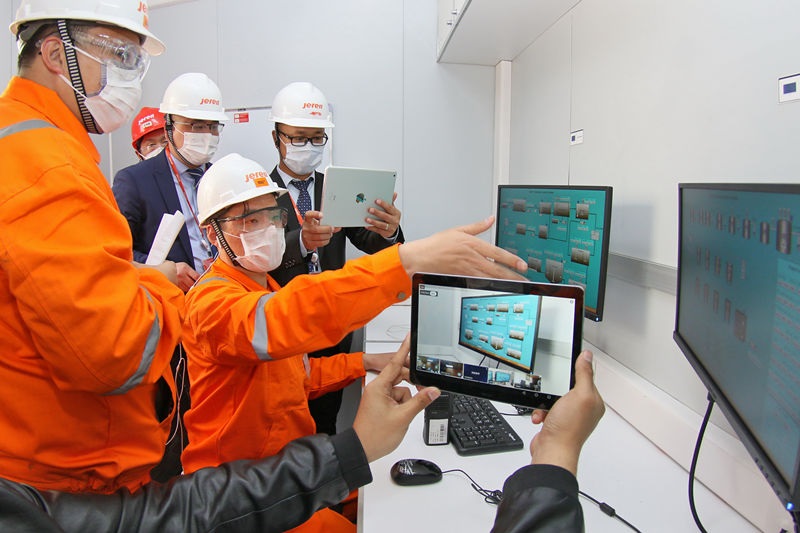


A live stream host demonstrates the products in a studio during the 2020 China Yiwu Network Broadcast and Short Video Industry Expo that kicked off in Yiwu, east China's Zhejiang province, on Sept. 26. (Photo by Gong Xianming/People's Daily Online)
As of June 2020, the number of online video users in China reached 888 million, accounting for 94.5 percent of the total Internet users of the country, data suggest.
Standing in the middle of a whirlwind, the online video industry is witnessing more forms of communication and gathering momentum.
Various forms of online videos, including live broadcasts, original video blogs and colorful short videos, are vivid expressions of people's daily life.
From the perspective of economic and social development, videos are not only meant for leisure and recreation, but also for creating value. They are both a carrier of information and a production factor.
The development and growth of the video industry have not only signaled its improving communication means and interaction ways, but generated new development opportunities for other industries.
During the COVID-19 epidemic prevention and control, online videos have been integrated with education, breaking the limitations on time and space of traditional educational resources and realizing the innovation of teaching methods.

Zhang Zhen, a student at a primary school in Yuquan district, Hohhot, north China's Inner Mongolia autonomous region, and his sister take an online P.E. class, Mar. 9. (Photo by Ding Genhou/People's Daily Online)
Online videos combined with health care have facilitated the development of Internet medical platforms and provided an easier access to medical consultations for people.
When connected with e-commerce, online videos have reshaped the consumption chain and driven the emergence of online shopping.
Meanwhile, "online videos plus office" have tackled certain pain points of companies with the wide application of video conferencing and telecommuting.
Videos have given full play to its characteristics such as high-efficiency, real-time transmission, and multi-functional quality in different industries and fields, and played an important role in the transformation and upgrading of industries.
Compared with other means of communication, videos seem to be more real and persuasive, and are believed to play a unique part in information dissemination and innovative governance.
Through online videos, tens of millions of netizens "watched" the construction of Huoshenshan Hospital and Leishenshan Hospital, both emergency specialty field hospitals built in Wuhan, central China's Hubei province, in response to the pandemic, and fostered strong mental power of fighting the virus through solidarity.
By rolling out short videos on popular science, science and technology bloggers and medical workers made practical suggestions regarding individuals' epidemic prevention to the audience.
Short video platforms have also joined hands with government officials and social media specialists around China to promote agricultural products and regional specialties via live-streaming videos.

Overseas video bloggers from the U.K. and Denmark record videos during their visit to the Dazu Rock Carvings scenic spot in southwest China's Chongqing municipality, July 2. (Photo by Huang Shu/People's Daily Online)
From macro-recording to micro-narrative, from on-the-spot viewing experience to in-depth interpretation, videos can provide viewers with adequate information and emotion increment, promote mainstream values and build social consensus in a complicated Internet environment.
The vigorous growth of video industry symbolizes the evolution of technology empowerment and is a result of industrial collaboration.
Every iteration of hardware and software, such as the growth of Chinese mobile phone brands like Huawei and Oppo and the popularity of video platforms including Douyin and Kuaishou in recent years, is an important driving force for the development of video socialization.
From 2G to 5G, information transmission efficiency and capacity have greatly increased, accelerating the accumulation of video production elements.
From millions of pixels to tens of millions of pixels, mobile phone cameras have seen significant improvement of their performance and algorithm, which simplifies the process of video decoding and encoding.
From folding screens to flexible screens, mobile phone manufacturers have made bold attempts in transforming imaging techniques and methods, enriching users' experience of viewing videos.
Technology empowerment, together with content-driven operation, has created numerous possibilities for the development of video industry.
The prospects of the video industry are clearly evident. However, it should be noted that the industry is also left with risks and challenges.
Some videos only focus on audio-visual experience without regard to values and that certain video platforms only care about view counts and pay no attention to their social responsibility.
Videos shouldn't just become an obsession with the audience. Instead, they should bring broader vision and richer knowledge to the viewers.

Photo taken on Mar. 30 shows technicians demonstrate their equipment in details and its function-testing process to Saudi customers via a live broadcast at Jereh, a global group specializing in oil & gas, power and environmental management in Yantai, east China's Shandong province. (Photo by Tang Ke/People's Daily Online)
Only those that highlight the values of the times and the sparkling features of humanity will exert influence and burst with vitality. To achieve this requires optimizing the content supplied by creators.
At the same time, it is necessary to be alert to the "information cocoons" of video platforms.
In other words, besides providing information and arousing emotion, video platforms need to focus on their responsibility.

 Award-winning photos show poverty reduction achievements in NE China's Jilin province
Award-winning photos show poverty reduction achievements in NE China's Jilin province People dance to greet advent of New Year in Ameiqituo Town, Guizhou
People dance to greet advent of New Year in Ameiqituo Town, Guizhou Fire brigade in Shanghai holds group wedding
Fire brigade in Shanghai holds group wedding Tourists enjoy ice sculptures in Datan Town, north China
Tourists enjoy ice sculptures in Datan Town, north China Sunset scenery of Dayan Pagoda in Xi'an
Sunset scenery of Dayan Pagoda in Xi'an Tourists have fun at scenic spot in Nanlong Town, NW China
Tourists have fun at scenic spot in Nanlong Town, NW China Harbin attracts tourists by making best use of ice in winter
Harbin attracts tourists by making best use of ice in winter In pics: FIS Alpine Ski Women's World Cup Slalom
In pics: FIS Alpine Ski Women's World Cup Slalom Black-necked cranes rest at reservoir in Lhunzhub County, Lhasa
Black-necked cranes rest at reservoir in Lhunzhub County, Lhasa China's FAST telescope will be available to foreign scientists in April
China's FAST telescope will be available to foreign scientists in April